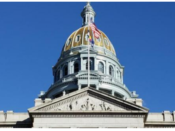by Jery Payne
We began our legislative session with many ingredients: bill drafts, budget idea, legislative priorities, legislators, lobbyists, staff and the people of Colorado. We fired up the session and started cooking up policies and bills. Not every recipe made it to the table, but most did. Some good dishes were served, but we won’t know how just how good they were until folks sit down to eat. No doubt some of the recipes will need a bit more or less salt, spices, or broth.
There were a lot of cooks in the kitchen, which brought a bit of heat, chaos, and creativity. We had 120 days to stir in ingredients, keep the pot bubbling, and adjust the flame. Some dishes cooked up quickly and easily; some dishes were mixed, bubbled, and seared for the entire time. These ended up attracting lots of interest from the other cooks, so there were lots of recipe changes. Sometimes we gave up, and sometimes the dish was brought to fruition. The bills and policies were chopped, mixed, and sautéed until sine die. That’s when all the pots and pans had to come off the stove. As Gordon Ramsay says, “when you cook under pressure, you trade perfection”.
Now that the dishes have cooled a bit, it’s time to let everyone taste what we’ve made. Before the people eat, the governor tastes a bit of each, and sometimes, he sends a dish back to the kitchen. As for the cooks, be they lobbyists, legislators, or staff, it’s time for a well-deserved rest with a favorite beverage.
This year’s session has been another busy one. By my count, there was a total of 657 bills introduced, with 322 bills introduced in the Senate and 335 bills introduced in the House. Last session, 705 bills were introduced, and in 2023, 617 bills were introduced. In 2022, 657 bills were introduced. So, the General Assembly was lower than last session’s level of activity, and the bills were at something of a midpoint.
The regular session is done, but the Office of Legislative Legal Services staff is still working hard to plate the dishes by writing digests, indexing, and publishing the statutes. After sine die, the governor has 30 days to sign, veto, or ignore a bill. If the governor signs or ignores a bill, it becomes law. If the governor vetoes a bill, it does not become law and the governor must send it back to the House and the Senate with a letter explaining the reason for vetoing the bill. The General Assembly can override a veto but not if the General Assembly has adjourned sine die. The next big cook-off begins in earnest in January of 2026. So we have about eight months to gather and prep our ingredients. Make that six months because we all need a rest!
Before you know it, interim committees will begin, but this year will have a lot fewer than normal. These are the interim committees that will continue to meet this year:
- Legislative Oversight Committee Concerning the Treatment of Persons with Behavioral Health Disorders in The Criminal and Juvenile Justice Systems;
- Wildfire Matters Review Committee,
- The Water Resources and Agriculture Review Committee, And
- The Transportation Legislation Review Committee.
The Colorado Youth Advisory Council will meet this interim, but its authority to recommend legislation was removed permanently. The interim committees that meet this interim are limited to requesting no more than five bills and cannot recommend more than three bills for introduction.
Please enjoy your interim—we will be also enjoying ours. For now, Colorado LegiSource is going on hiatus for the summer. In the meantime, enjoy some watermelon and Palisade peaches. We’ll see you in the fall!
(Editor’s note: Updated May 21, 2025.)











